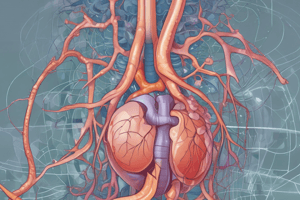Podcast
Questions and Answers
Which class of diuretics directly inhibits the sodium-potassium-chloride co-transporter?
Which class of diuretics directly inhibits the sodium-potassium-chloride co-transporter?
- Loop diuretics (correct)
- Thiazide diuretics
- Carbonic anhydrase inhibitors
- Osmotic diuretics
Which of the following diuretics is known to cause a loss of bicarbonate in the urine, potentially leading to acidosis?
Which of the following diuretics is known to cause a loss of bicarbonate in the urine, potentially leading to acidosis?
- Furosemide
- Acetazolamide (correct)
- Hydrochlorothiazide
- Mannitol
Which class of diuretics acts on the collecting tubules by inhibiting the action of aldosterone?
Which class of diuretics acts on the collecting tubules by inhibiting the action of aldosterone?
- Aldosterone antagonists (correct)
- Loop diuretics
- Sodium channel blockers
- Thiazide diuretics
What is the primary mechanism of action for osmotic diuretics like mannitol?
What is the primary mechanism of action for osmotic diuretics like mannitol?
Which of the following is a common side effect associated with the use of carbonic anhydrase inhibitors?
Which of the following is a common side effect associated with the use of carbonic anhydrase inhibitors?
What is the primary site of action for thiazide diuretics?
What is the primary site of action for thiazide diuretics?
Which of the following diuretics are considered potassium-sparing?
Which of the following diuretics are considered potassium-sparing?
How do sodium channel blockers like amiloride and triamterene reduce sodium reabsorption in the collecting tubules?
How do sodium channel blockers like amiloride and triamterene reduce sodium reabsorption in the collecting tubules?
What is the physiological effect of aldosterone on sodium and potassium handling in the collecting tubules?
What is the physiological effect of aldosterone on sodium and potassium handling in the collecting tubules?
Which of the following diuretics is most likely to cause hyperkalemia?
Which of the following diuretics is most likely to cause hyperkalemia?
What is the primary mechanism of action for osmotic diuretics?
What is the primary mechanism of action for osmotic diuretics?
Which of the following substances is NOT an example of an osmotic diuretic?
Which of the following substances is NOT an example of an osmotic diuretic?
What is the effect of increased glucose levels in the tubular fluid on urine production?
What is the effect of increased glucose levels in the tubular fluid on urine production?
What is the primary site of action for loop diuretics?
What is the primary site of action for loop diuretics?
Which of the following is NOT a consequence of loop diuretic use?
Which of the following is NOT a consequence of loop diuretic use?
What is the primary target of thiazide diuretics?
What is the primary target of thiazide diuretics?
Which of the following is the primary site of action for carbonic anhydrase inhibitors?
Which of the following is the primary site of action for carbonic anhydrase inhibitors?
What is the effect of carbonic anhydrase inhibitors on bicarbonate reabsorption?
What is the effect of carbonic anhydrase inhibitors on bicarbonate reabsorption?
What is the diuretic effect of loop diuretics compared to thiazide diuretics?
What is the diuretic effect of loop diuretics compared to thiazide diuretics?
Which of the following is a characteristic of osmotic diuretics?
Which of the following is a characteristic of osmotic diuretics?
What is the main effect of loop diuretics on the countercurrent multiplier system?
What is the main effect of loop diuretics on the countercurrent multiplier system?
What is the primary mechanism by which thiazide diuretics increase urine output?
What is the primary mechanism by which thiazide diuretics increase urine output?
What is a potential consequence of prolonged use of loop diuretics?
What is a potential consequence of prolonged use of loop diuretics?
What is the primary effect of diuretics on extracellular fluid volume?
What is the primary effect of diuretics on extracellular fluid volume?
Which of the following diuretic classes is commonly used to treat edema associated with heart failure?
Which of the following diuretic classes is commonly used to treat edema associated with heart failure?
What is the primary mechanism by which most clinically used diuretics exert their effect?
What is the primary mechanism by which most clinically used diuretics exert their effect?
What is the main clinical use of diuretics?
What is the main clinical use of diuretics?
How do diuretics typically reduce extracellular fluid volume?
How do diuretics typically reduce extracellular fluid volume?
What is a common consequence of the chronic use of diuretics?
What is a common consequence of the chronic use of diuretics?
Which of the following is NOT a solute whose renal excretion is influenced by sodium reabsorption?
Which of the following is NOT a solute whose renal excretion is influenced by sodium reabsorption?
What is the name for the increase in renal excretion of sodium caused by diuretics?
What is the name for the increase in renal excretion of sodium caused by diuretics?
Why does the effect of most diuretics on urine output tend to subside after a few days?
Why does the effect of most diuretics on urine output tend to subside after a few days?
What is the main reason for the clinical use of diuretics to lower extracellular fluid volume in conditions like edema and hypertension?
What is the main reason for the clinical use of diuretics to lower extracellular fluid volume in conditions like edema and hypertension?
Flashcards
Diuretics
Diuretics
Medications that increase urine output and solute excretion.
Natriuresis
Natriuresis
Increased excretion of sodium in urine.
Diuresis
Diuresis
Increased excretion of water in urine.
Renal tubular sodium reabsorption
Renal tubular sodium reabsorption
Signup and view all the flashcards
Compensatory mechanisms
Compensatory mechanisms
Signup and view all the flashcards
Extracellular fluid volume
Extracellular fluid volume
Signup and view all the flashcards
Glomerular filtration rate (GFR)
Glomerular filtration rate (GFR)
Signup and view all the flashcards
Renin secretion
Renin secretion
Signup and view all the flashcards
Osmotic Diuretics
Osmotic Diuretics
Signup and view all the flashcards
Diabetes Mellitus Effect
Diabetes Mellitus Effect
Signup and view all the flashcards
Loop Diuretics
Loop Diuretics
Signup and view all the flashcards
Effects of Loop Diuretics
Effects of Loop Diuretics
Signup and view all the flashcards
Thiazide Diuretics
Thiazide Diuretics
Signup and view all the flashcards
Carbonic Anhydrase Inhibitors
Carbonic Anhydrase Inhibitors
Signup and view all the flashcards
Renal Medullary Osmolarity
Renal Medullary Osmolarity
Signup and view all the flashcards
Polyuria
Polyuria
Signup and view all the flashcards
Polydipsia
Polydipsia
Signup and view all the flashcards
Sodium Excretion Impact
Sodium Excretion Impact
Signup and view all the flashcards
Glucose Transport Maximum
Glucose Transport Maximum
Signup and view all the flashcards
Countercurrent Multiplier System
Countercurrent Multiplier System
Signup and view all the flashcards
Thick Ascending Loop of Henle
Thick Ascending Loop of Henle
Signup and view all the flashcards
Citing Film of Diuretic Effects
Citing Film of Diuretic Effects
Signup and view all the flashcards
Aldosterone antagonists
Aldosterone antagonists
Signup and view all the flashcards
Sodium channel blockers
Sodium channel blockers
Signup and view all the flashcards
Potassium-sparing diuretics
Potassium-sparing diuretics
Signup and view all the flashcards
Diuretic mechanisms
Diuretic mechanisms
Signup and view all the flashcards
Tubular sites of action
Tubular sites of action
Signup and view all the flashcards
Sodium reabsorption
Sodium reabsorption
Signup and view all the flashcards
Study Notes
Diuretics and Their Mechanisms of Action
- Diuretics increase urine output and often solute excretion, mainly sodium and chloride.
- A primary mechanism involves decreasing renal tubular sodium reabsorption, leading to natriuresis (increased sodium excretion) and diuresis (increased water excretion).
- Water excretion increase due to sodium remaining in tubules, creating osmotic pressure preventing water reabsorption
- Many diuretics influence the excretion of other solutes (potassium, chloride, magnesium, calcium) which are co-influenced by sodium reabsorption.
- Diuretics are commonly used to reduce extracellular fluid volume in edema and hypertension.
- Initial diuretic effect on renal output is substantial (up to 20-fold increase in a few minutes), but chronic effects are mitigated by compensatory mechanisms.
- These compensatory responses (reducing arterial pressure, GFR, increasing renin/Ang II), eventually equalize sodium intake and excretion.
- Different diuretics target specific regions of the nephron.
Osmotic Diuretics
- Osmotic diuretics, like mannitol, urea, and sucrose, increase tubular fluid osmolarity by being filtered but poorly reabsorbed.
- This increased osmolarity reduces water reabsorption from tubules.
- High blood glucose levels (diabetes) can lead to osmotic diuresis when glucose exceeds the tubule’s reabsorption capacity.
- Elevated blood glucose above 250 mg/dl results in excess glucose in the tubules, causing osmotic diuresis and polyuria.
- Polyuria is countered by polydipsia (increased fluid intake) due to dehydration and high extracellular fluid osmolarity.
Loop Diuretics
- Loop diuretics (furosemide, ethacrynic acid, bumetanide) block the Na+-K+-2Cl- co-transporter in the thick ascending loop of Henle.
- This inhibits reabsorption, thus increasing urinary output of sodium, chloride, potassium, and water.
- Loop diuretics hinder the countercurrent multiplier system, reducing renal medullary osmolarity.
- This impairs the ability to dilute or concentrate urine as the concentration of the medullary interstitial fluid decreases
- Acutely, loop diuretics might increase urine output by twenty-five times (as much as 20%-30% of the glomerular filtrate).
Thiazide Diuretics
- Thiazide diuretics (chlorothiazide, hydrochlorothiazide) block the Na+-Cl- co-transporter in the early distal tubule.
- This leads to lesser sodium and water excretion if compared to loop diuretics, but they are useful in other conditions when loop diuretics might be contraindicated.
- Maximum effect of thiazides is about 5%-10% of glomerular filtrate; this can cause some of the normally reabsorbed sodium into the distal tubule, to end up in the urine.
Carbonic Anhydrase Inhibitors
- Carbonic anhydrase inhibitors (acetazolamide) block carbonic anhydrase in the proximal tubule.
- Inhibition reduces bicarbonate (HCO3-) reabsorption, affecting sodium reabsorption as well.
- This can contribute significantly (osmotically) to diuresis.
- Noteable disadvantage is a possible elevation in acidity.
Mineralocorticoid Receptor Antagonists
- Mineralocorticoid receptor antagonists (spironolactone, eplerenone) block aldosterone (receptors) in collecting tubules, reducing sodium reabsorption and increasing potassium excretion.
- These drugs are "potassium-sparing" diuretics because they prevent potassium loss.
- Excessive potassium can gather in extracellular fluids, which might be harmful in certain conditions.
Sodium Channel Blockers
- Sodium channel blockers (amiloride, triamterene). inhibit sodium reabsorption and potassium secretion in collecting tubules, similar to mineralocorticoid receptor antagonists.
- These diuretics are also potassium-sparing, as previously mentioned, mainly blocking Na+ entry to the collecting tubule cells' luminal membranes.
- By causing a reduced entry of sodium into the cells, it blocks Na+-K+ ATPase activity, consequently reducing potassium excretion.
Studying That Suits You
Use AI to generate personalized quizzes and flashcards to suit your learning preferences.




